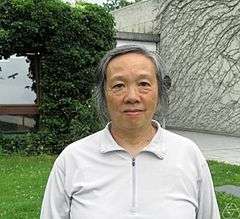Lai-Sang Young
Lai-Sang Lily Young (Chinese: 楊麗笙, born 1952) is a Hong Kong-born American mathematician who holds the Henry & Lucy Moses Professorship of Science and is a professor of mathematics and neural science at the Courant Institute of Mathematical Sciences of New York University. Her research interests include dynamical systems, ergodic theory, chaos theory, probability theory, statistical mechanics, and neuroscience.[1] She is particularly known for introducing the method of Markov returns in 1998, which she used to prove exponential correlation delay in Sinai billiards and other hyperbolic dynamical systems.[2]

Education and career
Although born and raised in Hong Kong, Young came to the US for her education, earning a bachelor's degree from the University of Wisconsin–Madison in 1973. She moved to the University of California, Berkeley for her graduate studies, earning a master's degree in 1976 and completing her doctorate in 1978, under the supervision of Rufus Bowen.[3][4][5][6] She taught at Northwestern University from 1979 to 1980, Michigan State University from 1980 to 1986, the University of Arizona from 1987 to 1990, and the University of California, Los Angeles from 1991 to 1999. She has been the Moses Professor at NYU since 1999.[3][4][5]
Awards and honors
Young became a Sloan Fellow in 1985,[3][5] and a Guggenheim Fellow in 1997.[4][7]
In 1993, Young was given the Ruth Lyttle Satter Prize in Mathematics of the American Mathematical Society "for her leading role in the investigation of the statistical (or ergodic) properties of dynamical systems".[8] This is a biennial award for outstanding research contributions by a female mathematician.[3]
In 2004, she was elected as a fellow of the American Academy of Arts and Sciences.[3][9]
Young was an invited speaker at the International Congress of Mathematicians in 1994,[5] and an invited plenary speaker at the 2018 International Congress of Mathematicians.[10] In 2005, she presented the Noether Lecture of the Association for Women in Mathematics; her talk was entitled "From Limit Cycles to Strange Attractors".[3] In 2007, she presented the Sonia Kovalevsky lecture, jointly sponsored by the AWM and the Society for Industrial and Applied Mathematics.[4][11]
In 2020 she was elected a member of the National Academy of Sciences.[12]
Selected publications
- Block, Louis; Guckenheimer, John; Misiurewicz, Michał; Young, Lai Sang (1980), "Periodic points and topological entropy of one-dimensional maps", Global theory of dynamical systems (Proc. Internat. Conf., Northwestern Univ., Evanston, Ill., 1979), Lecture Notes in Mathematics, 819, Berlin: Springer, pp. 18–34, doi:10.1007/BFb0086977, MR 0591173.
- Young, Lai Sang (1982), "Dimension, entropy and Lyapunov exponents", Ergodic Theory and Dynamical Systems, 2 (1): 109–124, doi:10.1017/S0143385700009615, MR 0684248.
- Benedicks, Michael; Young, Lai-Sang (1993), "Sinaĭ–Bowen–Ruelle measures for certain Hénon maps", Inventiones Mathematicae, 112 (3): 541–576, doi:10.1007/BF01232446, MR 1218323.
- Young, Lai-Sang (1998), "Statistical properties of dynamical systems with some hyperbolicity", Annals of Mathematics, Second Series, 147 (3): 585–650, doi:10.2307/120960, MR 1637655.
- Young, Lai-Sang (1999), "Recurrence times and rates of mixing", Israel Journal of Mathematics, 110: 153–188, doi:10.1007/BF02808180, MR 1750438.
- Wang, Qiudong; Young, Lai-Sang (2001), "Strange attractors with one direction of instability", Communications in Mathematical Physics, 218 (1): 1–97, doi:10.1007/s002200100379, MR 1824198.
- Young, Lai-Sang (2002), "What are SRB measures, and which dynamical systems have them?", Journal of Statistical Physics, 108 (5–6): 733–754, doi:10.1023/A:1019762724717, MR 1933431.
References
- Lai-Sang Young, New York University, retrieved 2015-06-07.
- Szász, D. (2000), Hard ball systems and the Lorentz gas, Encyclopaedia of Mathematical Sciences, 101, Berlin: Springer-Verlag, p. 3, ISBN 3-540-67620-1, MR 1805337.
- Lai-Sang Young: From Limit Cycles to Strange Attractors, Association for Women in Mathematics, 2005, archived from the original on 2015-06-29, retrieved 2015-06-07.
- Riddle, Larry (January 10, 2014), "Lai-Sang Young", Biographies of Women Mathematicians, Agnes Scott College, retrieved 2015-06-07.
- O'Connor, John J.; Robertson, Edmund F., "Lai-Sang Young", MacTutor History of Mathematics archive, University of St Andrews.
- Lai-Sang Lily Young at the Mathematics Genealogy Project
- Guggenheim fellows: Lai-Sang Young, John Simon Guggenheim Memorial Foundation, retrieved 2015-06-07.
- Browse Prizes and Awards: Ruth Lyttle Satter Prize in Mathematics, American Mathematical Society, retrieved 2015-06-07.
- American Academy Announces 2004 Fellows and Foreign Honorary Members, American Academy of Arts and Sciences, April 30, 2004, retrieved 2015-06-07.
- "Plenary lectures", ICM 2018, archived from the original on 2018-01-14, retrieved 2018-08-08
- Lai-Sang Young to deliver AWM-SIAM Sonia Kovalevsky Lecture (PDF), Association for Women in Mathematics, March 30, 2007, retrieved 2015-06-07.
- National Academy of Sciences Elects New Members
External links
- Young's Homepage
- "Dynamical systems evolving – Lai-Sang Young – ICM2018". YouTube. 19 September 2018. (Plenary Lecture 8)

